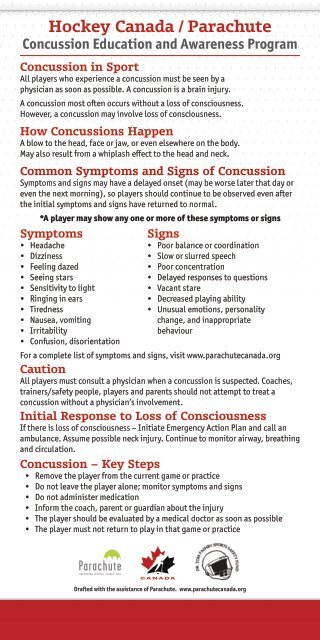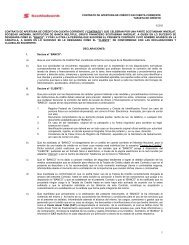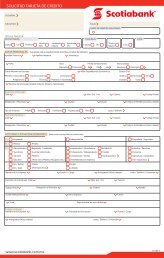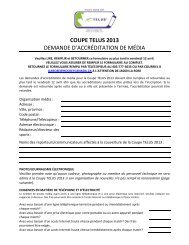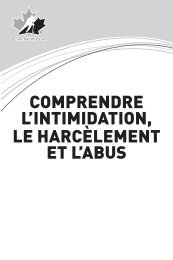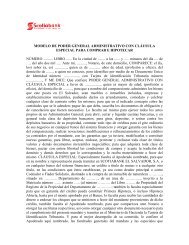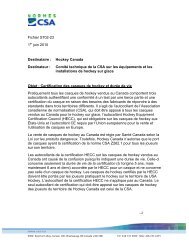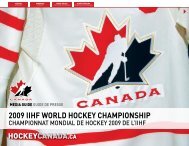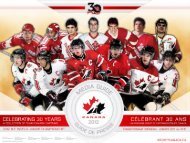Hockey Canada / Parachute
Hockey Canada Concussion Card - Agility CMS
Hockey Canada Concussion Card - Agility CMS
Create successful ePaper yourself
Turn your PDF publications into a flip-book with our unique Google optimized e-Paper software.
<strong>Hockey</strong> <strong>Canada</strong> / <strong>Parachute</strong><br />
Concussion Education and Awareness Program<br />
Concussion in Sport<br />
All players who experience a concussion must be seen by a<br />
physician as soon as possible. A concussion is a brain injury.<br />
A concussion most often occurs without a loss of consciousness.<br />
However, a concussion may involve loss of consciousness.<br />
How Concussions Happen<br />
A blow to the head, face or jaw, or even elsewhere on the body.<br />
May also result from a whiplash effect to the head and neck.<br />
Common Symptoms and Signs of Concussion<br />
Symptoms and signs may have a delayed onset (may be worse later that day or<br />
even the next morning), so players should continue to be observed even after<br />
the initial symptoms and signs have returned to normal.<br />
*A player may show any one or more of these symptoms or signs<br />
Symptoms<br />
• Headache<br />
• Dizziness<br />
• Feeling dazed<br />
• Seeing stars<br />
• Sensitivity to light<br />
• Ringing in ears<br />
• Tiredness<br />
• Nausea, vomiting<br />
• Irritability<br />
• Confusion, disorientation<br />
Signs<br />
• Poor balance or coordination<br />
• Slow or slurred speech<br />
• Poor concentration<br />
• Delayed responses to questions<br />
• Vacant stare<br />
• Decreased playing ability<br />
• Unusual emotions, personality<br />
change, and inappropriate<br />
behaviour<br />
For a complete list of symptoms and signs, visit www.parachutecanada.org<br />
Caution<br />
All players must consult a physician when a concussion is suspected. Coaches,<br />
trainers/safety people, players and parents should not attempt to treat a<br />
concussion without a physician’s involvement.<br />
Initial Response to Loss of Consciousness<br />
If there is loss of consciousness – Initiate Emergency Action Plan and call an<br />
ambulance. Assume possible neck injury. Continue to monitor airway, breathing<br />
and circulation.<br />
Concussion – Key Steps<br />
• Remove the player from the current game or practice<br />
• Do not leave the player alone; monitor symptoms and signs<br />
• Do not administer medication<br />
• Inform the coach, parent or guardian about the injury<br />
• The player should be evaluated by a medical doctor as soon as possible<br />
• The player must not return to play in that game or practice<br />
Drafted with the assistance of <strong>Parachute</strong>. www.parachutecanada.org
6 Step Return to Play<br />
The return to play process is gradual, and begins after a doctor has given the<br />
player clearance to return to activity. If any symptoms/signs return during this<br />
process, the player must be re-evaluated by a physician. No return to play if<br />
any symptoms or signs persist. Remember, symptoms may return later that day<br />
or the next, not necessarily when exercising!<br />
Step 1: No activity, only complete mental and physical rest. Proceed to<br />
step 2 only when all symptoms are gone. This includes avoiding both mental<br />
and physical stress.<br />
Step 2: Light aerobic exercise, such as walking or stationary cycling.<br />
Monitor for symptoms and signs. No resistance training or weight lifting.<br />
Step 3: Sport specific activities and training (e.g. skating).<br />
Step 4: Drills without body contact. May add light resistance training and<br />
progress to heavier weights.<br />
The time needed to progress from non-contact to contact exercise will vary<br />
with the severity of the concussion and the player. Go to step 5 after medical<br />
clearance. (reassessment and note)<br />
Step 5: Begin drills with body contact.<br />
Step 6: Game play. (The earliest a concussed athlete should return to play<br />
is one week).<br />
Note: Players should proceed through return to play steps only when they<br />
do not experience symptoms or signs and the physician has given clearance.<br />
Each step should be a minimum of one day. If symptoms or signs return, the<br />
player should return to step 1, and be re-evaluated by a physician.<br />
Never return to play if symptoms persist!<br />
Prevention Tips<br />
Players<br />
• Make sure your helmet fits snugly<br />
and that the strap is fastened<br />
• Get a custom fitted mouth guard<br />
• Respect other players<br />
• No hits to the Head<br />
• No hits from behind<br />
Coach/Trainer/Safety<br />
Person/Referee<br />
• Eliminate all checks to the head<br />
• Eliminate all hits from behind<br />
• Recognize symptoms and signs of<br />
concussion<br />
• Inform and educate players about<br />
the risks of concussion<br />
Education Tips<br />
www.hockeycanada.ca<br />
See Smart <strong>Hockey</strong> Program at<br />
www.parachutecanada.org<br />
Dr. Tom Pashby Sport Safety Fund website<br />
www.drpashby.ca<br />
Drafted with the assistance of <strong>Parachute</strong>.<br />
Revised May 2015. Item # 55711


